
Morchella, the true morels, is a genus of edible sac fungi closely related to anatomically simpler cup fungi in the order Pezizales. These distinctive fungi have a honeycomb appearance due to the network of ridges with pits composing their caps. Morels are prized by gourmet cooks, particularly in Catalan and French cuisine. Due to difficulties in cultivation, commercial harvesting of wild morels has become a multimillion-dollar industry in the temperate Northern Hemisphere, in particular North America, Turkey, China, the Himalayas, India, and Pakistan where these highly prized fungi are found in abundance.
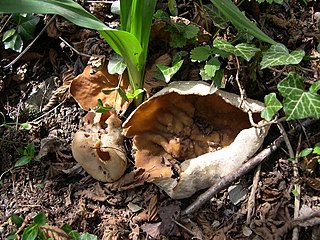
Disciotis is a genus of fungi in the family Morchellaceae. Members of this family, characterized by their cup- or bowl-shaped apothecia, have a widespread distribution, especially in northern temperate regions.

Morchella elata is a species of fungus in the family Morchellaceae. It is one of many related species commonly known as black morels, and until 2012 the name M. elata was broadly applied to black morels throughout the globe. Like most members of the genus, M. elata is a popular edible fungus and is sought by many mushroom hunters.
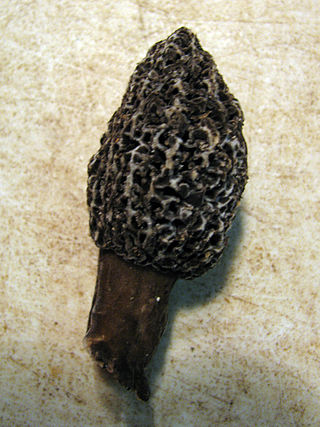
Morchella tomentosa, commonly called the gray, fuzzy foot, or black foot morel, is a species of fungus in the family Morchellaceae. M. tomentosa is a fire-associated species described from western North America, formally described as new to science in 2008.

Morchella rufobrunnea, commonly known as the blushing morel, is a species of ascomycete fungus in the family Morchellaceae. A choice edible species, the fungus was described as new to science in 1998 by mycologists Gastón Guzmán and Fidel Tapia from collections made in Veracruz, Mexico. Its distribution was later revealed to be far more widespread after several DNA studies suggested that it is also present in the West Coast of the United States, Israel, Australia, Cyprus, Malta and Switzerland.

Morchella tridentina is a cosmopolitan species of ascomycete fungus in the family Morchellaceae. Commonly referred to as the mountain blond or western blond morel in North America, it produces conical, grey to buff fruit bodies that are rufescent and grow up to 20 cm (7.9 in) tall and 5 cm (2.0 in) wide. This early-diverging species is distinct within the /Elata clade due to its pale colours and has been described by many names in the past, including M. frustrata, M. quercus-ilicis, M. elatoides, M. elatoides var. elegans and M. conica var. pseudoeximia, all of which were shown to be synonyms. A widely distributed relict of the last Ice Age, M. tridentina is so far known from Argentina, Armenia, Chile, Cyprus, France, India, Israel, North America, Spain and Turkey.
Morchella ulmaria is a species of fungus in the family Morchellaceae. It was described as new to science in 2012 by Philippe Clowez. Later in the same year, Michael Kuo and colleagues described Morchella cryptica, which is a junior synonym of M. ulmaria. The species occurs in the forests of Midwestern North America, often associated with white ash, the American tulip tree or species of maple or elm. It is closely related to M. castanea and 2 unnamed species from Asia.

Morchella americana is a North American species of fungus in the family Morchellaceae.
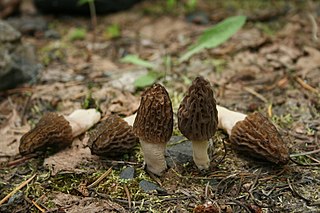
Morchella brunnea is a species of fungus in the family Morchellaceae. Described as new to science in 2012, it is known from Oregon, where it fruits under hardwood trees.
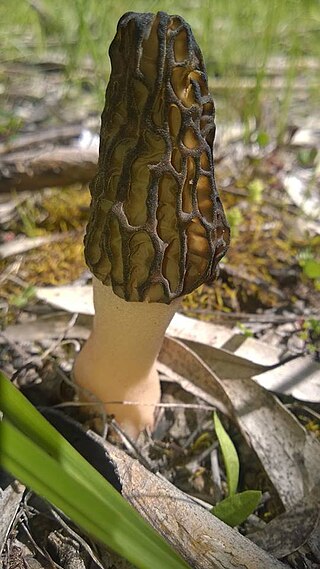
Morchella australiana is a species of ascomycete fungus in the family Morchellaceae. Described as new to science in 2014, it is found in New South Wales, South Australia,Tasmania and Victoria, Australia. The type locality was in the temperate Pilliga Scrub of northwestern New South Wales, west of the Great Dividing Range. Fruit bodies of the fungus resemble those of the European Morchella elata, but molecular and morphological analyses demonstrated that the Australian species represents a unique lineage.
Morchella guatemalensis is a species of ascomycete fungus in the family Morchellaceae. Described as new to science in 1985, it is found in Chimaltenango Department (Guatemala), where it grows in oak and cypress woodland. The fruit body has a white stipe and orangish cap.

Morchella arbutiphila is a species of fungus in the family Morchellaceae (Ascomycota), described from the island of Cyprus in 2016. The species is notable for its elongated stipe, which is often longer than the cap's length, its ascospores which are larger than most other species of Morchella, and its highly specific ecological preferences. It is known only from igneous substrates of the Troodos mountains in Cyprus and from a single collection in the Aegean region of Turkey.
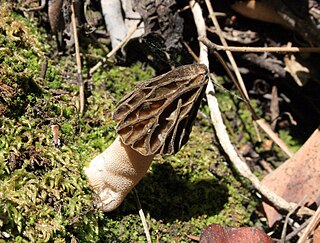
Morchella disparilis is an Ascomycete fungus in the family Morchellaceae. Described as new to science in 2016, M. disparilis appears to be confined to the Mediterranean basin and is so far known from Cyprus, Greece and Spain. Its most striking feature is the exceptionally deep sinus, intermediate in depth between half-free morels of the Morchella semilibera clade and typical Distantes species.

Morchella fluvialis is a species of fungus in the family Morchellaceae. It was described as new to science in 2014 by Clowez and colleagues, following collections from riparian forests in Spain under Alnus glutinosa, Ulmus minor and Eucalyptus camaldulensis, although previous collections from Turkey under Pinus nigra have also been reported. This species, which corresponds to phylogenetic lineage Mes-18, is very close to Morchella esculenta, from which it differs in its elongated cap with oblong pits and predominantly longitudinal ridges, pronounced rufescence, as well as its Mediterranean hygrophilic distribution along rivers and streams.
Morchella palazonii is a species of morel found in Spain.
Morchella kakiicolor is a species of fungus in the family Morchellaceae (Ascomycota). It was originally proposed as a form of Morchella quercus-ilicis in a 2012 study by Philippe Clowez, but was later re-combined as an autonomous species by Loizides and colleagues, based on molecular phylogenetic data. In the same study, M. quercus-ilicis f. quercus-ilicis was shown by the authors to be a later synonym of the old taxon Morchella tridentina, and not phylogenetically related to M. kakiicolor.
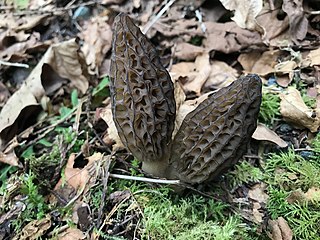
Morchella eohespera is a species of fungus in the family Morchellaceae described as new to science in 2016. In North America, it has been collected from Newfoundland and Labrador, New Brunswick, British Columbia, Canada and in Washington state. It is also found in central and northern Europe, and central China. It is in the Morchella elata clade.
Morchella laurentiana is a species of fungus in the family Morchellaceae described as new to science in 2016. It is known only from the Saint Lawrence River basin in the Canadian province of Newfoundland and Labrador. It is in the Morchella elata clade.
Morchella casteneae is a species of fungus in the family Morchellaceae (Ascomycota). It was described as new to science in a 2012 study by Clowez and appears to be confined to the Iberian peninsula. A subsequent phylogenetic and nomenclatural study by Richard and colleagues has confirmed M. castaneae as a distinct species and showed the taxa Morchella brunneorosea and Morchella brunneorosea var. sordida to be synonymous.

Morchella sceptriformis is a species of fungus in the family Morchellaceae (Ascomycota). It was described as new to science in a 2012 study by Clowez, and corresponds to phylogenetic lineage Mes-3. Morchella virginiana, described later in the same year by Kuo and colleagues, is conspecific to this taxon.













